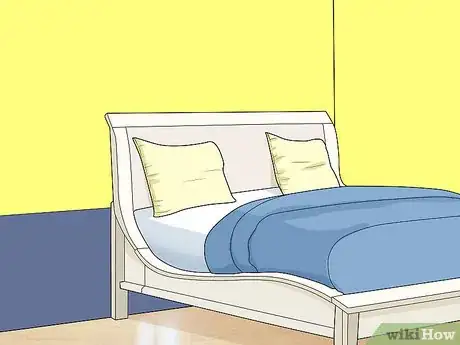This article was co-authored by Suzanne Lasky, ASID. Suzanne Lasky is an Interior Designer and the Founder of S Interior Design, a design consulting company based in Scottsdale, Arizona specializing in new home builds, home remodels, and all related design options for residential and small business clients. Suzanne has over 19 years of interior design and consulting experience. She is an Allied Member of the ASID (American Society of Interior Designers). She earned a Master of Business Administration (MBA) from Indiana University and an AAS in Interior Design from Scottsdale Community College.
There are 8 references cited in this article, which can be found at the bottom of the page.
This article has been viewed 34,978 times.
Like most rooms in your house, your bedroom may start to feel boring and outdated after a while. Whether you want to freshen up your room with some new paint or do a complete remodel, you can get it done safely and efficiently with the proper planning. Once you have a plan, work on painting, picking furniture, and adding the final touches of decor!
Steps
Remodeling on a Budget
-
1Decide what your inspiration or style will be for the room. Whether it’s rustic, farmhouse, modern, or something entirely different, pick a design style to help you choose furniture, paint colors, and décor. This will help to make the room look cohesive and intentional, rather than a mix of different styles.[1]
- Sometimes, you can get inspiration from a painting, a piece of furniture, or a quilt that you really love. Then, you can make it a focal point of your new room.
- Try looking at design websites like Architectural Digest, Better Homes and Gardens, or HGTV for inspiration. Save pictures of the rooms that you like so you can reference them later.
-
2Choose an overall color scheme for your room. Interior design relies a lot on color schemes, so pick 1 “main” color to use throughout your room, like a neutral taupe, crisp white, muted gray, or pale pink. Then, choose 1-2 extra “accent” colors to complement your main color and add fun, eye-catching details.[2]
- For example, if you’re doing a bohemian theme, you might choose a light cream color for your main color, with bright pink, gold, and turquoise as your accent colors.[3]
- If you’re doing a farmhouse theme, you could choose crisp white for the main color, and use a French blue and bright yellow for your accent colors.
- Try using an item, such as a throw pillow or Afghan, to help you choose colors for the room.
Advertisement -
3Paint the walls to transform your room with a new color. Pick a main color to go on your walls, and remove all of the furniture from the room to repaint.[4] Try to stick with your color scheme if you want to do multiple colors, and choose a shade that will complement many colors, even if your tastes change!
- If you want to add some interest to the room, paint one of the walls in your accent color to create depth!
- For a smaller room, you can pick brighter colors like light cream or white to make the room seem larger and brighter.
- Stick with neutral paint colors if you plan to incorporate bold, colorful décor, or if you plan to change out your décor often.
-
4Repurpose and update your furniture to fit your new style. It’s surprisingly easy to refinish old furniture to give it a fresh look. You can paint wooden items, reupholster a thrifted chair, or decorate the headboard of your bed. This is a very budget-friendly idea because you don’t have to buy new items.[5]
- If you do want a few new pieces of furniture, visit a thrift store or look on Craigslist for cheap and free items that people don’t want.
- Something as simple as draping a new throw blanket over a piece of furniture can update it.
-
5Select a new bedding set and pillows that match your color scheme. With your color scheme in mind, pick out a duvet or quilt, pillow shams and covers, and a few throw pillows for your bed. It’s best to keep the quilt or duvet a solid color or simple pattern, and add pops of color with pillows. You can even lay a throw blanket in a complementary color across the end of the bed to pull everything together.[6]
- For example, for a farmhouse theme using white walls with accent colors of blue, and yellow, you could have a blue duvet with pale yellow throw pillows.
- To save money, choose quality sheets and less expensive throw pillows and blankets.
-
6Rearrange the furniture to give your space a new purpose. Move the furniture that you have around in the room to test which setup makes the most sense for your room. Try to give yourself at least 3 feet (0.91 m) of walking space between pieces of furniture. This will help the room feel spacious and open, even if you have a lot of furniture.[7]
- For a more open space, select a focal point for the room and position your furniture along the walls.
- If you want a more traditional look for your bedroom, position your headboard along a wall and place a nightstand on either side.
- For most rooms, it’s best to place your dresser along an empty wall so that you have enough space to access it.
- To avoid moving objects around multiple times, sketch out the room and furniture to scale to see what type of arrangement works best.
-
7Pick a couple of lamps to brighten up the room. Lighting is important for making your bedroom feel cozy and bright. Choose a set of matching lamps, and place one on your nightstand, with the other somewhere else in your room. If you have a second nightstand, you can place it there, or on the dresser.[8]
- For a cozier feel, you can use string lights along your ceiling or hung between walls to give the room some ambient lighting.
- You can also add a brightly colored lamp shade for a pop of color that coordinates with your color scheme.
- For example, if you’re doing a rustic or farmhouse theme, look for a lamp with a wooden base and a brightly colored lampshade.
- Switching out an overhead light fixture in a bedroom for a softer lighting option can also help to make the room seem more relaxing and romantic.
-
8Add some comfortable chairs to create a separate sitting area. To make your bedroom multipurpose, designate an area for relaxing by setting up a comfortable chair and a small table. Look for a chair that’s upholstered with an accent or neutral color, and pick a fun statement table.[9]
- If you don’t have a lot of space, you can make a seating area by positioning a small bench at the foot of your bed, or you can get a set of floor pillows to make sitting on the floor a bit more comfortable.
-
9Hang up some artwork or a mirror on an empty wall. To add some fun pieces to your room, position a piece of art or a mirror on an empty wall, like the wall above your bed. If you don’t have space above your headboard, choose a wall that doesn’t have anything on it.[10]
- Look for pieces of art that match your general theme or color scheme. This will help to pull the room together.
- Hanging up pictures of family and friends can also help to make a room seem cozier and more inviting.
Making Big Renovations
-
1Contact a contractor for an estimate if you want help from a professional. For remodels that include an addition to the room, removing walls, or other structural changes to the home, it’s best to set up an appointment with a professional contractor in your area. Normally, the contractor will come to your home, talk about the remodel with you, and survey the room to see what they’re working with. Then, they’ll give you an estimate for the cost of work and materials.[11]
- When talking to a contractor, be as specific as possible about what you’d like the room to look like. If you have inspiration pictures, show them.
- Keep in mind that while using a contractor is more expensive, they can save you time and ensure that the work is done properly.
-
2Consider doing the renovations yourself if you want to save money. For some big renovations, like refinishing floors, removing trim, or even taking out small, non-load-bearing walls, it’s possible to do the project by yourself. Before you take on any project, make sure you have the proper tools and understand the risks.[12]
- Do-it-yourself renovations can be a very stressful learning experience, and your project might not turn out exactly as you planned.
- If you start doing a project and find that you’re in over your head, don’t be afraid to contact a professional for help or advice.
-
3Set a reasonable budget for your renovations. For an average remodel, plan to spend about $110 per 1 foot (0.30 m) squared. If you’re going to be re-doing a closet or expanding the room, be sure to include that area in your calculations.[13]
- If you’re doing a remodel that requires a lot of demolition, or you plan to add new flooring, add an additional $15-$30 per 1 foot (0.30 m) squared. The price will depend on what kind of flooring you’re using or how you’re doing the demolition.
- Keep in mind that doing demolition and renovations yourself will save you money. Then, you can hire a professional to do the parts of the renovation that you cannot do on your own.
-
4Sketch out a floor plan for your ideal bedroom. Once you’ve decided on the style and know how much space you’ll have, make a general drawing of the room that you can refer back to throughout the renovations. Include the places where you’d like to put furniture, mark any doors, and note where there are windows.[14]
- Your sketch doesn’t have to be detailed or even to scale. You should just have a general idea of where you’d like to put everything.
-
5Consider removing a wall to combine rooms and expand your space. If there’s a smaller room adjacent to your bedroom that you rarely use, you might want to take out the wall to incorporate the space from that room into the bedroom. Make sure the wall isn’t load-bearing, and double check that removing it will provide the amount of space that you’re looking for.[15]
- This is also a great method for adding a larger closet or ensuite bathroom to your bedroom.
- Keep in mind that removing a bedroom or bathroom can negatively affect the value of your home. Before committing to combining 2 bedrooms, talk to an appraiser to see how the value of your home could change.
- If you don’t want to remove a wall, then you could add a door between 2 adjacent rooms, such as a sliding barn door or pocket door. This will keep the rooms separate while providing more space.
-
6Refinish or replace the floors for a relatively inexpensive update. If you already have hardwood floors or have hardwood under carpeting, consider making it a focal point to your room. Changing from carpet to wood can change the entire feel of the room. Making the switch from carpet to hardwood normally has a high return on investment, but it’s important to do each step correctly to ensure that the flooring will last a long time.[16]
- If you currently have older carpeting in your room, you might consider replacing it with new carpeting for a fresh look. Try to pick a neutral color that will match your desired theme.
- Compared to expanding the room or purchasing new furniture, replacing the floors can be pretty cheap and give the room a whole new look.
- If replacing the floors is not an option, then purchase a large area rug to cover them.
-
7Pick a set or multiple pieces of furniture that fit your desired style. Once the room is remodeled, you can add furniture to the bedroom. For totally new furniture, plan to purchase a bed frame, mattress, nightstand, and a dresser. You can purchase these in a matching set, or find a mix of pieces from different stores.[17]
- If you don’t have a lot of closet space, you might consider getting an extra dresser or an armoire to hold your clothes.
- For mismatched furniture, search at places like antique stores and flea markets for unique pieces.
References
- ↑ Suzanne Lasky, ASID. Interior Designer. Expert Interview. 31 March 2020.
- ↑ https://www.architecturaldigest.com/gallery/12-stunning-bedroom-paint-ideas-for-your-master-suite/all
- ↑ Suzanne Lasky, ASID. Interior Designer. Expert Interview. 31 March 2020.
- ↑ Suzanne Lasky, ASID. Interior Designer. Expert Interview. 31 March 2020.
- ↑ Suzanne Lasky, ASID. Interior Designer. Expert Interview. 31 March 2020.
- ↑ https://www.goodhousekeeping.com/home/decorating-ideas/g770/decor-ideas-master-bedroom/
- ↑ https://www.bhg.com/decorating/lessons/basics/how-to-arrange-furniture/
- ↑ https://www.goodhousekeeping.com/home/decorating-ideas/g770/decor-ideas-master-bedroom/
- ↑ http://www.traditionalhome.com/design/bedrooms/beautiful-bedroom-sitting-areas
- ↑ https://www.apartmenttherapy.com/bedrooms-with-properly-hung-art-229742
- ↑ https://www.bhg.com/home-improvement/remodeling/additions/planning-home-additions/
- ↑ https://www.bhg.com/home-improvement/remodeling/additions/planning-home-additions/
- ↑ https://www.hgtv.com/remodel/interior-remodel/budgeting-for-your-bedroom-remodel
- ↑ https://www.bhg.com/home-improvement/remodeling/additions/planning-home-additions/
- ↑ https://www.bhg.com/home-improvement/remodeling/additions/planning-home-additions/
- ↑ https://www.bhg.com/home-improvement/remodeling/additions/planning-home-additions/
- ↑ https://www.goodhousekeeping.com/home/decorating-ideas/g770/decor-ideas-master-bedroom/












































































